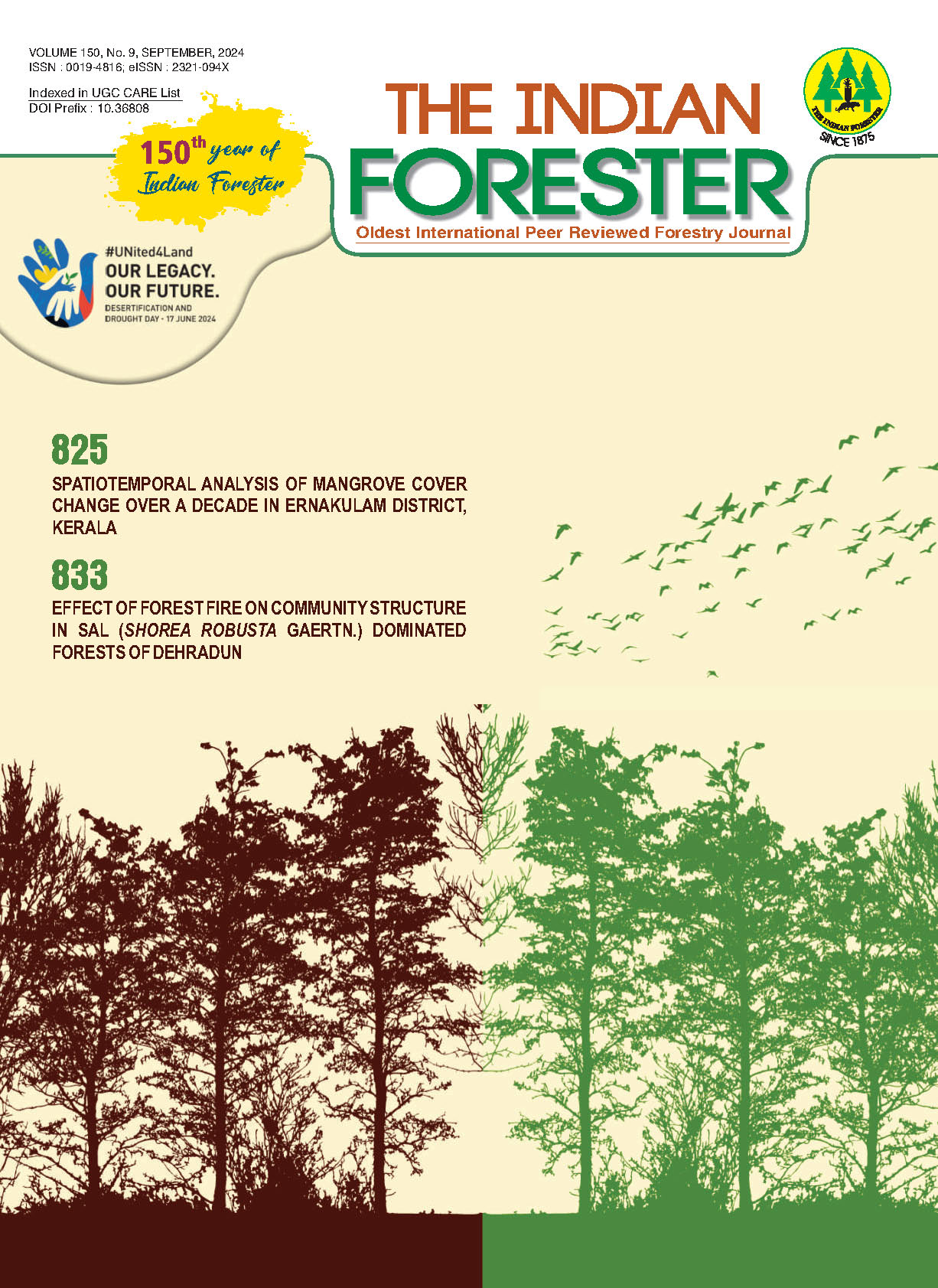Spatiotemporal Analysis of Mangrove Cover Change over a Decade in Ernakulam District, Kerala
DOI:
https://doi.org/10.36808/if/2024/v150i9/170564Keywords:
Mangrove Cover, Change Detection, Accuracy Assessment, NDVI, NDWI, CMRI.Abstract
Mangrove ecosystems, crucial coastal habitats, are increasingly threatened by human encroachment, making it essential to monitor their changes over time for effective conservation. This study uses remote sensing and GIS to create Mangrove Cover maps for 2014 and 2024, examining spatiotemporal patterns of mangrove cover in Ernakulam district, India, over the past decade. By applying the Combined Mangrove Recognition Index (CMRI), derived from the Normalized Difference Vegetation Index (NDVI) and Normalized Difference Water Index (NDWI) from Landsat 8 and 9 data, the study enhances mangrove identification. The analysis reveals a decrease in mangrove cover from 922.05 hectares in 2014 to 802.53 hectares in 2024, with some areas remaining stable and others showing minor regrowth. Vypin, the district's largest mangrove area, remained relatively steady, while locations like Cherai Beach and Wellington Island experienced declines, likely due to coastal erosion and development. A field visit to 1,150 ground reference points confirmed 851 as mangroves, yielding a kappa coefficient accuracy of 74%. This research underscores the value of integrating remote sensing with field surveys to inform targeted conservation and management strategies for Ernakulam's mangroves.References
Alongi D.M. (2008). Mangrove forests: resilience, protection from tsunamis, and responses to global climate change. Estuarine, Coastal and Shelf Science, 76(1): 1-13.
Ferreira A.C., Borges R. and de Lacerda L.D. (2022). Can sustainable development save mangroves? Sustainability, 14(3): 1263.
Gao L., Wang X., Johnson B.A., Tian Q., Wang Y., Verrelst J. and Gu X. (2020). Remote sensing algorithms for estimation of fractional vegetation cover using pure vegetation index values: A review. ISPRS Journal of Photogrammetry and Remote Sensing, 159: 364-377.
Gilman E.L., Ellison J., Duke N.C. and Field C. (2008). Threats to mangroves from climate change and adaptation options: a review. Aquatic Botany, 89(2): 237-250.
Giri C., Long J., Abbas S., Murali R.M., Qamer F.M., Pengra B. and Thau D. (2015). Distribution and dynamics of mangrove forests of South Asia. Journal of Environmental Management, 148: 101-111.
Gupta K., Mukhopadhyay A., Giri S., Chanda A., Majumdar S.D., Samanta S., Mitra D., Saml R.N., Pattnaik A.K. and Hazra S. (2018). An index for discrimination of mangroves from non-mangroves using LANDSAT 8 OLI imagery. Methods X 5: 1129–1139.
Hema M. and Indira Devi P. (2014). Factors of mangrove destruction and management of mangrove ecosystem of Kerala, India. Journal of Aquatic Biology and Fisheries, 2: 184-196.
Kerala Tourism Department. (n.d.). Ernakulam. http://www.keralatourism.gov.in/
Le T.S., Harper R. and Dell B. (2023). Application of remote sensing in detecting and monitoring water stress in forests. Remote Sensing, 15(13): 3360.
Luom T.T., Phong N.T., Smithers S. and Van Tai T. (2021). Protected mangrove forests and aquaculture development for livelihoods. Ocean & Coastal Management, 205: 105553.
Olokeogun O.S. and Kumar M. (2020). An indicator-based approach for assessing the vulnerability of riparian ecosystem under the influence of urbanization in the Indian Himalayan city, Dehradun. Ecological Indicators, 119-106796. https://doi.org/10.1016/j.ecolind.2020.106796.
Olokeogun O.S. and Kumar M. (2022). Indicator-based vulnerability assessment of riparian zones in Nigeria's Ibadan region due to urban settlement pressure. Environmental Challenges 7-100501. https://doi.org/10.1016/j.envc.2022.100501.
Phiri D. and Morgenroth J. (2017). Developments in Landsat land cover classification methods: A review. Remote Sensing, 9(9): 967.
Quang P.D., Phommachaly S. and Hoa N.H. (2022). Using Sentinel-2a Derived CMRI for Mangrove Cover Mapping over 7 Years (2016-2022) in Quang Yen, Quang Ninh Province. Journal of Forestry Science and Technology, 14: 141-152.
Sakinah F., Ranggadara I., Karima I.S. and Suhendra S. (2022). Spatio-Temporal Analysis Coastal Areas for Detection Mangrove Greenery Using Combined Mangrove Recognition Index. In 2022 International Seminar on Application for Technology of Information and Communication (iSemantic) (pp. 273-277). IEEE.
Spalding M. (2010). World atlas of mangroves. Routledge.
Sumangala K.N., Akhil P.S. and Sujatha C.H. (2013). Hydrogeochemical quality assessment of ground waters in Ernakulam District, Kerala, India. J. Environ. Sci. Comput. Sci. Eng. Tech, 2(4): 1353-1368.
Tong Yang X., Liu H. and Gao X. (2015). Land cover changed object detection in remote sensing data with medium spatial resolution. International Journal of Applied Earth Observation and Geoinformation, 38: 129-137.
Downloads
Downloads
Published
How to Cite
Issue
Section
License
Unless otherwise stated, copyright or similar rights in all materials presented on the site, including graphical images, are owned by Indian Forester.





